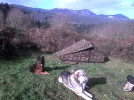Michelle Menhennet
Member
- Time of past OR future Camino
- Plan to walk around 2022
I’ve seen threads on this topic buried in miscellaneous threads, but I think it’s worth having a stand alone thread in Personal Safety. Lots of people run into dogs on the Camino who are fiercely protecting territory or livestock and some even bitten. The best way to deal with them can be a bit counterintuitive. Here’s some great advice from a wise vet:
WHAT TO DO IF THREATENED BY AN AGGRESSIVE DOG: BE A TREE!
1) Remain calm and still. Don't run. This is a race you will not win. If you are alone, back away slowly. Do not turn your back.
2) If you are on the ground, curl into a fetal position, cover your head with your arms, and keep your fingers curled in a fist.
3) Avoid eye contact. Remember, staring an aggressive dog in the eyes is a challenge.
4) Do not smile at the dog
5) Use a soft, soothing tone of voice. Loud, angry-sounding words and screaming only spur on the dog.
6) If he bites you, DO NOT PULL AWAY. This only spurs the dog on. Remain calm. Try to put something between you and the dog like your purse, jacket, bicycle, backpack, etc. Don't hit the dog. Again, just makes the situation worse.
WHAT TO DO IF YOU GET BITTEN
1) If the bite is serious, call 911.
2) Wash the bite wound thoroughly with soap and water. If the wound is deep, painful, discolored, or swollen, contact your medical professional.
3) If possible, confirm the dog's rabies vaccination status.
4) Report the bite to your local authorities and veterinarian.
WHAT TO DO IF THREATENED BY AN AGGRESSIVE DOG: BE A TREE!
1) Remain calm and still. Don't run. This is a race you will not win. If you are alone, back away slowly. Do not turn your back.
2) If you are on the ground, curl into a fetal position, cover your head with your arms, and keep your fingers curled in a fist.
3) Avoid eye contact. Remember, staring an aggressive dog in the eyes is a challenge.
4) Do not smile at the dog
5) Use a soft, soothing tone of voice. Loud, angry-sounding words and screaming only spur on the dog.
6) If he bites you, DO NOT PULL AWAY. This only spurs the dog on. Remain calm. Try to put something between you and the dog like your purse, jacket, bicycle, backpack, etc. Don't hit the dog. Again, just makes the situation worse.
WHAT TO DO IF YOU GET BITTEN
1) If the bite is serious, call 911.
2) Wash the bite wound thoroughly with soap and water. If the wound is deep, painful, discolored, or swollen, contact your medical professional.
3) If possible, confirm the dog's rabies vaccination status.
4) Report the bite to your local authorities and veterinarian.

























